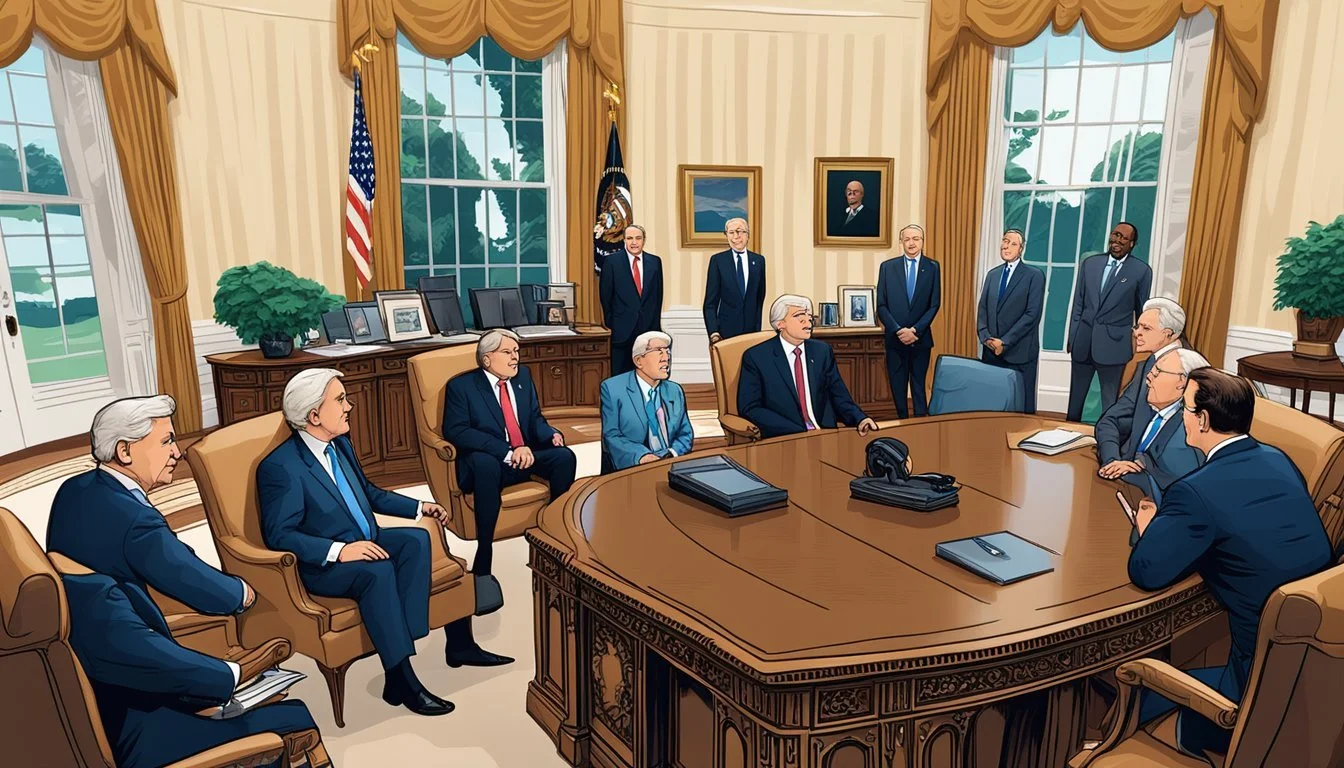Examining the Key Players in President Trumps Administration
Key Players and Positions in 2025 Administration
Donald Trump's Cabinet played a crucial role during his presidency from 2017 to 2021. As the head of the executive branch, Trump had the authority to nominate Cabinet members for Senate confirmation. His selections reflected his political priorities and shaped the direction of his administration.
The Cabinet consisted of the heads of various executive departments, advising the president on matters related to their respective areas of expertise. Trump's choices for these positions were notable for their backgrounds in business, military, and conservative politics.
Throughout his term, Trump's Cabinet saw significant turnover, with several members resigning or being replaced. This dynamic reflected the often tumultuous nature of his presidency and sparked ongoing discussions about the stability and effectiveness of his administration's leadership.
Formation of the Cabinet
Donald Trump's cabinet formation involved a structured process of nomination and confirmation, adhering to constitutional requirements. The cabinet's composition reflected Trump's priorities and political considerations.
Legal Framework and Senate Confirmation
The U.S. Constitution empowers the president to nominate cabinet members, subject to Senate confirmation. Trump began this process shortly after his election in November 2016.
The Senate holds hearings to evaluate nominees' qualifications and suitability for their roles. This process can be rigorous, with senators questioning candidates on policy positions and past experiences.
Some of Trump's nominations faced scrutiny. For example, Rex Tillerson's nomination for Secretary of State sparked debate due to his lack of government experience and ties to Russia through his work at ExxonMobil.
Composition and Hierarchy
Trump's cabinet included 15 executive department heads and additional cabinet-level officials. The hierarchy typically follows the order of succession to the presidency.
Key positions included:
Secretary of State
Secretary of the Treasury
Secretary of Defense
Attorney General
Trump's initial cabinet was notably diverse in professional backgrounds, including business executives, politicians, and military leaders. It was less diverse in terms of gender and ethnicity compared to previous administrations.
The cabinet's composition evolved over Trump's term, with several high-profile departures and replacements. This turnover rate was higher than in previous administrations, reflecting Trump's management style and policy shifts.
Key Cabinet Positions
The Cabinet plays a crucial role in shaping policy and advising the President. Donald Trump's administration saw several notable figures occupy key positions, with some turnover during his term.
Secretary of State
Rex Tillerson served as Trump's first Secretary of State from 2017 to 2018. The former ExxonMobil CEO faced challenges in implementing Trump's foreign policy vision.
Mike Pompeo succeeded Tillerson in 2018. Pompeo, previously CIA Director, aligned more closely with Trump's views on international relations.
Both Secretaries dealt with complex issues like North Korea negotiations and Middle East peace efforts.
Secretary of the Treasury
Steven Mnuchin held this position throughout Trump's presidency. The former Goldman Sachs executive played a key role in shaping economic policy.
Mnuchin oversaw major tax reform legislation in 2017. He also managed economic responses to the COVID-19 pandemic in 2020.
His tenure focused on promoting economic growth and job creation.
Secretary of Defense
James Mattis, a retired Marine Corps general, served as Trump's first Defense Secretary from 2017 to 2018. Mattis required a congressional waiver due to his recent military service.
Mark Esper took over in 2019 after Patrick Shanahan's brief acting role. Esper, a former Army officer and defense industry executive, led the Pentagon until late 2020.
Both Secretaries navigated complex global security challenges and military modernization efforts.
Attorney General
Jeff Sessions, a former Alabama Senator, became Trump's first Attorney General. His tenure was marked by tensions with Trump over the Russia investigation.
William Barr succeeded Sessions in 2019. Barr, who had previously served as Attorney General under George H.W. Bush, faced controversy over his handling of the Mueller Report.
Deputy Attorney General Jeffrey Rosen briefly took over as Acting Attorney General in the final weeks of Trump's term.
The Role of Vice President
Mike Pence served as Vice President during Donald Trump's administration, playing a significant part in Cabinet affairs and policy decisions. His role involved balancing traditional vice presidential duties with unique responsibilities in the Trump White House.
Involvement in Cabinet Affairs
Mike Pence attended Cabinet meetings and acted as a key liaison between the president and Cabinet members. He chaired the National Space Council, overseeing space policy initiatives. Pence also led the coronavirus task force, coordinating the administration's pandemic response.
The Vice President traveled extensively, representing the administration both domestically and internationally. He advocated for Trump's policies on trade, foreign relations, and domestic issues during these trips.
Pence maintained a loyal public persona, often defending Trump's decisions and statements. However, their relationship became strained towards the end of the administration, particularly over the events of January 6, 2021.
Other Prominent Cabinet Roles
Several key positions in Trump's cabinet played crucial roles in shaping policy and overseeing major government agencies. These roles were subject to turnover and controversy during Trump's term.
Homeland Security Secretary
Kirstjen Nielsen initially led the Department of Homeland Security under Trump. She oversaw controversial immigration policies, including family separations at the southern border. Nielsen resigned in April 2019 amid tensions with Trump over border security.
Chad Wolf succeeded Nielsen as Acting Secretary. He continued tough immigration enforcement and oversaw the department's response to civil unrest in 2020. Wolf's appointment faced legal challenges over its legitimacy.
The department dealt with issues like cybersecurity, counterterrorism, and disaster response during this period. Leadership changes impacted policy continuity and morale within the agency.
Environmental Protection Agency
Scott Pruitt served as EPA Administrator from 2017 to 2018. He pursued an aggressive deregulation agenda, rolling back Obama-era environmental rules. Pruitt faced multiple ethics scandals related to spending and conflicts of interest.
Andrew Wheeler replaced Pruitt in 2018. A former coal lobbyist, Wheeler continued deregulatory efforts more quietly. He oversaw relaxed emissions standards for power plants and vehicles.
The EPA under Trump prioritized reducing regulations on industry. This shift sparked legal challenges from environmental groups and some states.
Central Intelligence Agency
Gina Haspel became Director of the CIA in 2018, the first woman to hold the position. A career intelligence officer, Haspel faced scrutiny over her involvement in the CIA's post-9/11 interrogation program.
Haspel managed to maintain a relatively low public profile as CIA Director. She focused on traditional intelligence gathering and analysis while navigating a sometimes tense relationship between Trump and the intelligence community.
The CIA under Haspel continued to address threats from countries like Russia, China, and North Korea. Cybersecurity and counterterrorism remained key priorities for the agency during this period.
Subordinate Agencies and Administrations
The Trump administration oversaw numerous agencies and offices that played crucial roles in shaping and implementing policy. These entities spanned intelligence, economic, and health domains, providing specialized expertise to support executive decision-making.
National Intelligence and Security
The Office of the Director of National Intelligence coordinated intelligence gathering and analysis across 17 agencies. John Ratcliffe served as DNI from 2020-2021, focusing on threats from China and election security.
The National Security Council, led by National Security Advisors including John Bolton and Robert O'Brien, provided guidance on foreign policy and national security matters. Key priorities included North Korea negotiations and Middle East peace efforts.
Economic and Trade Advisories
The National Economic Council, directed by Gary Cohn and later Larry Kudlow, advised on economic policy. It championed tax cuts and deregulation to stimulate growth.
The Council of Economic Advisers, chaired by Kevin Hassett from 2017-2019, provided economic analysis and forecasts. It promoted policies like the 2017 Tax Cuts and Jobs Act.
The U.S. Trade Representative, Robert Lighthizer, led trade negotiations and policy. He pursued an "America First" agenda, renegotiating NAFTA and imposing tariffs on China.
Health and Human Services
The Department of Health and Human Services, led by Secretaries Tom Price and Alex Azar, oversaw healthcare policy and the COVID-19 response. It worked to repeal and replace the Affordable Care Act.
The Centers for Disease Control and Prevention played a central role in the pandemic response, issuing guidance on mitigation measures and vaccine distribution.
The National Institutes of Health, under Dr. Francis Collins, conducted and funded critical medical research, including rapid COVID-19 vaccine development efforts.
Controversies and Criticisms
Donald Trump's cabinet faced significant challenges and scrutiny throughout his presidency. The administration grappled with personnel issues, policy disagreements, and intense public attention.
High Turnover and Resignations
The Trump administration experienced unprecedented turnover rates among cabinet members. Several high-profile officials departed, including Secretary of State Rex Tillerson and Attorney General Jeff Sessions. Defense Secretary James Mattis resigned in protest over policy differences.
The frequent changes disrupted continuity in key departments. Critics argued this instability hampered effective governance and policy implementation. Supporters countered that Trump was assembling the right team to achieve his goals.
Policy Disputes and Internal Tensions
Cabinet members often clashed with Trump on major policy issues. Trade Representative Robert Lighthizer disagreed with the president on tariff strategies. Interior Secretary Ryan Zinke faced criticism for his department's environmental policies.
Ben Carson, leading Housing and Urban Development, sparked controversy with comments on poverty and budget proposals. Energy Secretary Rick Perry initially opposed the department he later led.
These conflicts sometimes played out publicly, revealing rifts within the administration.
Public and Media Scrutiny
Trump's cabinet faced intense media coverage and public criticism. Ethics concerns emerged over officials' use of government resources. Some cabinet members drew fire for lavish spending on office decor or travel.
The media closely monitored cabinet officials' statements and actions. Public gaffes or controversial remarks often led to negative press cycles. Cabinet members found themselves defending administration policies in contentious congressional hearings.
This heightened scrutiny added pressure to an already challenging political environment.
Impact and Legacy
Donald Trump's presidency left a significant mark on American politics and society. His administration implemented wide-ranging policies and reforms that continue to shape national discourse and global affairs.
National and Global Policies
Trump's "America First" approach redefined U.S. foreign policy. He withdrew from international agreements like the Paris Climate Accord and Iran nuclear deal. The administration renegotiated trade deals, including NAFTA, and imposed tariffs on China.
Trump's immigration policies included travel bans on several Muslim-majority countries and efforts to build a wall along the U.S.-Mexico border. These actions sparked intense debates on national security and immigration reform.
The Trump administration increased military spending and pursued a more assertive stance towards North Korea and Iran. It also brokered normalization agreements between Israel and several Arab states.
Economic and Social Reforms
Trump's signature economic policy was the 2017 Tax Cuts and Jobs Act, which lowered corporate tax rates and modified individual tax brackets. The administration also focused on deregulation, rolling back environmental protections and financial regulations.
The appointment of three conservative justices to the Supreme Court reshaped the judicial landscape. This shift led to significant rulings on issues like abortion rights and executive power.
Trump's response to the COVID-19 pandemic, including Operation Warp Speed for vaccine development, became a defining aspect of his presidency. His handling of the crisis drew both praise and criticism.
Long-Term Effects on Governance
Trump's presidency challenged traditional norms of political discourse and behavior. His use of social media, particularly Twitter, changed how leaders communicate with the public.
The administration's skepticism towards climate change science led to rollbacks of environmental regulations and a shift in U.S. energy policy towards fossil fuels.
Trump's claims of election fraud in 2020 and the events of January 6, 2021, raised concerns about the stability of democratic institutions. These events continue to influence political debates and election processes.
The Republican Party underwent significant changes during Trump's tenure, with his populist style reshaping party priorities and rhetoric. This transformation continues to impact GOP strategy and policy positions.





